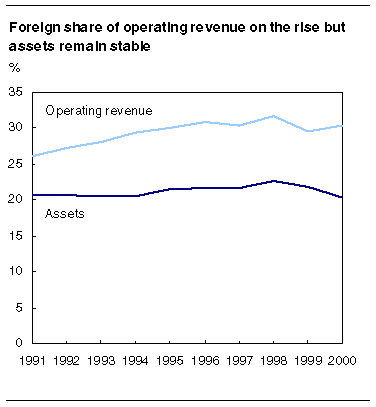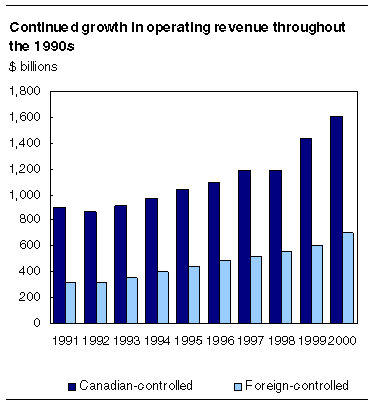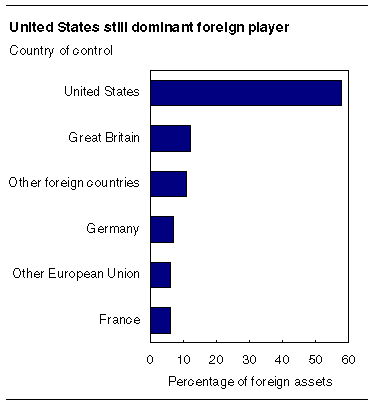
















 |
|
 |                |
Information identified as archived is provided for reference, research or recordkeeping purposes. It is not subject to the Government of Canada Web Standards and has not been altered or updated since it was archived. Please "contact us" to request a format other than those available.

|

Wednesday, November 5, 2003 Foreign control in the Canadian economy2000Foreign control in the Canadian economy - as measured by the share of assets for all corporations - declined for the second straight year in 2000, returning to levels recorded a decade earlier. Foreign-controlled firms held one-fifth of assets in Canada in 2000, virtually identical to the proportion in 1991. The rate had risen slightly during the late 1990s. On the other hand, a second measurement, the share of operating revenues earned by foreign-controlled firms, exhibited a slightly stronger performance, increasing steadily throughout the 1990s. As a result, foreign-controlled firms generated 30% of total operating revenues in 2000, compared with only 26% in 1991. 
The value of assets held by Canadian-controlled enterprises increased at five times the pace of assets held by foreign-controlled firms in 2000 alone. Canadian-controlled corporations reported nearly $3,200 billion in assets, an 11% increase from 1999, while foreign-controlled assets stood at $810 billion, up only 2%. In the case of operating revenues, corporations under foreign control recorded the larger gain in 2000. Their revenues reached $704 billion, up 16% from 1999, while those for Canadian-controlled firms rose 12% to just over $1,600 billion. Asset-based measures of foreign control provide a longer-term perspective, reflecting economic decisions and market conditions that evolve more slowly over time. Revenue-based measures tend to reflect current business conditions and, therefore, tend to be more volatile than asset-based measures. Decade in perspective: Foreign, Canadian assets grew at virtually same paceOver the entire decade, the assets held by Canadian and foreign-controlled corporations grew at virtually the same pace. From 1991 to 2000, Canadian-controlled corporations reported an 81% increase in assets, barely faster than the 77% gain reported by foreign-controlled corporations. For operating revenues, it was the eighth straight year of growth for Canadian-controlled corporations, and the ninth straight for foreign-held corporations. During the 1990s, foreign-controlled operating revenues more than doubled, while Canadian-controlled revenues rose at a somewhat slower pace (+79%). 
One reason could be that Canadian-controlled corporations appeared to have more difficulty rebounding immediately following the 1991 recession. However, after 1992, growth in operating revenues for all corporations rose quickly for two years before stabilizing in the mid 1990s. In 2000, the pace picked up again. United States by far biggest foreign playerThe United States again dominated the foreign-controlled share of both corporate operating revenue and assets in Canada. U.S.-controlled corporations accounted for 58% of foreign control in assets and 65% in operating revenues. In terms of foreign-controlled asset share, Great Britain was a distant second, far behind the United States at only 12%. Using foreign-controlled operating revenue share as the measure, this time Germany placed second, well back of the United States at only 8%. Assets held by U.S.-controlled corporations operating in Canada were close to double those of corporations controlled by the European Union, while their operating revenues were almost triple those of European Union-controlled corporations. 
Foreign control more prevalent in non-financial sectorForeign control was more prevalent in the non-financial sector of the economy, where foreign interests held 26% of assets and generated 31% of operating revenues in 2000. In contrast, in the finance and insurance sector, foreign-controlled firms had only 15% of assets and 21% of operating revenues. This was primarily because of tighter regulatory controls in this sector of the economy. For the most part, foreign control of assets in both the non-financial and the finance and insurance sectors remained relatively stable during the 1990s, although the finance and insurance sector experienced a slight downturn in 2000. In terms of operating revenues, the foreign-controlled share rose slowly during the decade in the non-financial sector. In the finance and insurance sector, however, foreign control in operating revenues ended the decade where it started. After experiencing mild growth during the mid-1990s, foreign control in this sector declined in 2000. This occurred primarily because of merger and acquisition activity in the Canadian banking industry, combined with demutualization in the insurance carriers industry. Foreign control was most prevalent in the manufacturing and oil and gas extraction industries in the non-financial sector in 2000. Manufacturing, the largest industry group in this sector, accounted for just over one-half of both assets and operating revenues under foreign control. Banking again dominates finance and insurance sectorForeign control in the finance and insurance sector was most prevalent in non-depository credit intermediation, which includes credit providing and financing companies, where just over half the assets and operating revenue are foreign controlled. Foreign-controlled enterprises also had a significant presence in the insurance industry, where foreign-controlled firms accounted for 30% of assets and 33% of operating revenues. But the largest industry in the sector, deposit credit intermediation, has less than 10% of both its assets and operating revenue come from enterprises under foreign control. Accounting for 70% of the sector's assets and 43% of its operating revenues, this industry includes the chartered banks and credit unions. The majority of these assets and revenues come from enterprises under Canadian control because of government regulations restricting foreign ownership in this industry. Economic performance: Operating profits jump one-fifthOperating profits, a measure of economic performance, increased 20% in 2000 to $192 billion, in response to growth in demand for goods and services. Operating profits reported by Canadian-controlled corporations jumped 20% to $134 billion, while those of foreign-controlled corporations rose 21% to $58 billion. Foreign-controlled corporations accounted for only 30% of total operating profits in 2000, the same as the year before. Canadian-controlled companies generated a strong majority of the profits in both the finance and insurance sector and the non-financial sector. Both Canadian and foreign-controlled firms reported profit margins, on average, of 8.3% in 2000. The margin for foreign-controlled firms rose slightly from 8.0% in 1999, while the margin for Canadian-controlled firms went up from 7.8%. Available on CANSIM: table 179-0004. Definitions, data sources and methods: survey number 2503. The report Corporations Returns Act - Foreign control in the Canadian economy, 2000 (61-220-XIE, $32) is now available. For more information, or to enquire about the concepts, methods or data quality of this release, contact David Sabourin (613-951-3735), Industrial Organization and Finance Division. |
|
|
|